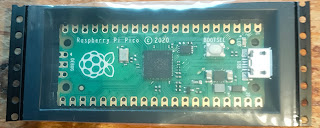Getting started with the Raspberry Pi pico
I'm always excited when Eben Upton pulls another Raspberry Pi rabbit out of his capacious topper.
Last week he announced the $4 Raspberry Pi pico. It's a unique product for several reasons, and I put an order in as soon as I saw the announcement.It's easy to get the pico going
The pico's on-line documentation is superb and it's supplemented by an excellent and inexpensive book from Gareth Halfacree and Ben Everard.
I did hit one minor 'gotcha'. I've been working on my main workstation which runs Linux Mint, and discovered the hard way that the Thonny Editor won't install properly if you're using Python 3.5Python 3.5 has reached end-of-life, but it's still the default on Linux Mint 18.3. If I want to use a later version I have to set up a virtual environment. Once I did that, Thonny installed perfectly and within a couple of minutes I'd created a Hello World script and run it on the pico.
If you're using a Raspberry Pi to program the pico you won't have this problem, as the current version of Raspberry Pi OS has Python 3.7 installed.
Raspberry Pi partners with Pimoroni, Adafruit, sparkfun and Arduino
I mentioned that the pico was unique for several reasons. One I find particularly exciting: the RP2040 chip at the heart of the pico will be used in products from Pimoroni, Adafruit, sparkfun and Arduino as well as the Raspberry Pi Foundation.
It's great to see these movers and shakers cooperating in this way. It makes good commercial sense. This cooperation will create more opportunities for us all, and will expand the market as a result.
I'll be documenting my pico exploration as I go. Follow @rareblog on twitter if you want to stay informed.





Comments
Post a Comment